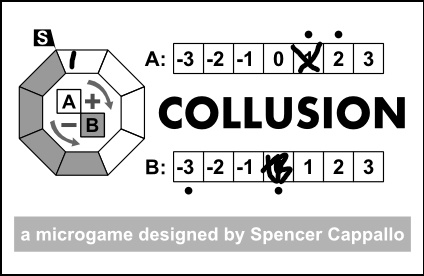
Collusion is an experiment in minimalism: a game that fits on a business card (minus rules). It’s also an experiment in random decisions cohering into meaningful play. With no turns, there is no first player advantage.
The board

How to play
Collusion is played over 7 rounds, during which players are vying to position the marker in their section of the ring. Every round that the marker is in your color of square, you gain a point. At the end of the seventh round, whoever has the most points wins.
To start, one player is designated as Player A and one player as Player B. Each round, both players (secretly, simultaneously) pick a number in their row of numbers. The marker is then moved clockwise a number of steps equal to the sum of the two numbers. e.g., if player A chooses +2 and player B -3, the marker moves -1 space clockwise (which is 1 space counter-clockwise). The marker’s current position is indicated by writing the number of the round in the space (1 for the first round, up to 7 for the final round). The moves selected are crossed off in both player A and player B’s rows. These numbers can not be chosen again for the rest of the game. For the first move, both players must choose one of the two numbers in their row of numbers with a black dot next to it. The marker begins in the gap between two spaces (marked with “S” for “Start”). After the first move, the current position of the marker will always be within a space, never between two spaces.
At the end of all seven rounds, if the marker is in a shaded space, player B wins. If it is in a white space, player A wins.
Example of play
Alfred and Bertha are playing collusion. It is the first move, so both players must choose from only the black-dotted moves. Alfred secretly decides to move to move 1 space (clockwise), and Bertha decides to move 0 spaces. They both indicate that they have decided their moves, and reveal their decisions (honor system!). The marker moves 1+0 = 1 space clockwise. It therefore winds up in the space just to the right of the start, and the players mark it with a “1”. Both players also cross out the numbers they have chosen.

For the second round, the players will choose from their remaining six options to move from the spot now marked with a “1”.
Commentary
This game has several interesting qualities. It has no first player advantage (though it does have a slight player bias with A vs B). The first move is more or less random, but subsequent moves are significant. As a game that is only 7 moves long, there’s a surprising amount of play, too. I made a few different variants of this, including some without the virtual starting space (instead, players started on a particular space). I also ran out the complete (fairly small) game tree to make sure the board designs were balanced sufficiently well.